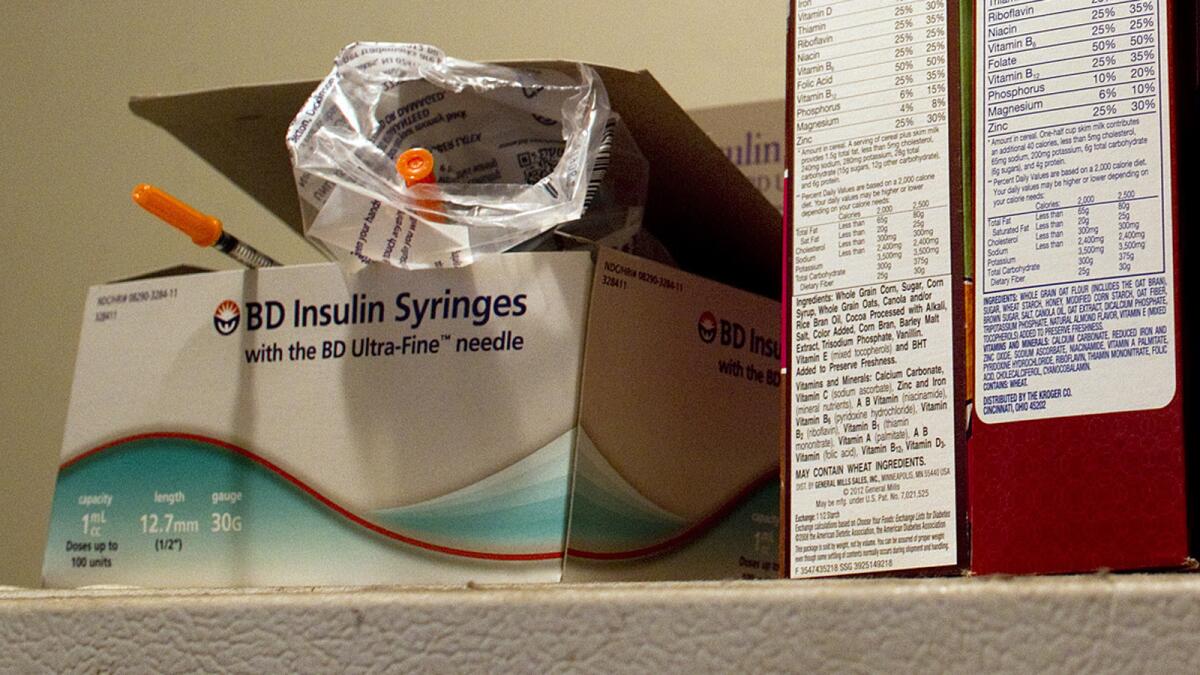U.S. rate of Type 2 diabetes stabilizes, CDC reports

After growing steadily for nearly two decades, the rate of Type 2 diabetes among American adults appears to have stalled, according to a comprehensive new study from researchers at the Centers for Disease Control and Prevention.
The CDC team said the plateau may be a downstream effect of another positive trend: a stabilization of obesity rates in the U.S. first seen in 2003 and 2004.
However, the metabolic disorder continues to spread among African Americans and Latinos, researchers report in Wednesday’s edition of the Journal of the American Medical Assn. And among Americans ages 20 to 44 and those with a high school education or less, the likelihood of a diabetes diagnosis is still rising as well.
“It’s good news in a way, but it’s not good news for everybody,” said Shakira Suglia, an epidemiologist at Columbia University’s Mailman School of Public Health who wasn’t involved in the JAMA study. While many Americans have gotten the message that better food choices and more exercise can keep diabetes at bay, she added, “we’re just not reaching certain populations.”
The new research assessed changes in the prevalence of diabetes (the rate at which the disease is present in an overall population) and its incidence (the rate at which new diagnoses are made within a given time frame).
Prevalence gives a sense of a disease’s overall public health impact, while incidence allows physicians and public health authorities to infer an individual’s average risk of developing a disease. Collectively, measures of incidence and prevalence make it possible to compare the disease risk among groups based on such characteristics as gender, age and ethnicity.
Fueled by the runaway spread of obesity in the 1970s and 1980s, the rate of Type 2 diabetes among American adults ages 20 to 79 more than doubled from 3.5% in 1990 to 7.9% in 2008, the study found. In 2012, that figure was essentially unchanged at 8.3%.
In addition, for every 1,000 Americans in that age group, 3.2 were diagnosed with diabetes in 1990 and 8.8 would be newly diagnosed in 2008. By 2012, that figure fell to 7.1.
The statistics are based on the responses of 664,969 American adults who answered annual health surveys. The questionnaire does not distinguish between Type 1 and Type 2 diabetes. But Type 1 — in which patients are unable to make insulin to convert food into fuel — represents only about 5% of new diagnoses in adults, and experts say there’s no reason for it to have become more common.
By contrast, rates of Type 2 diabetes — in which patients lose their ability to use insulin efficiently — have certainly grown. Obesity and a sedentary lifestyle are major risk factors for the chronic disease, which makes patients more likely to suffer a heart attack, stroke, kidney failure, blindness or pain or numbness in the lower extremities that can lead to amputation.
The study authors acknowledged that their results probably understate the true prevalence of diabetes in the United States, since an estimated 28% of diabetes sufferers never receive a formal diagnosis. If rates of detection have not changed, however, the findings do provide a useful gauge of the rate and extent of diabetes’ spread.
CDC statistics show that in 2012, 29.1 million Americans — nearly 1 in 10 — suffered from either Type 1 or Type 2 diabetes, but only 21 million knew they had the disease.
The shifting tides of obesity and diabetes have major economic implications for U.S. healthcare spending. Lifetime medical costs for those with diabetes are roughly twice as high as for those without.
For groups that are still seeing higher rates of diabetes, public health experts will have to offer more than exhortation to turn things around, Suglia said.
“With certain populations, you have to look beyond” messages that promote more healthful eating and more exercise, she said. For adults working two jobs to feed their families, or coping with violent neighborhoods, “these factors fall down on the list of priorities, so there has to be a bigger effort to go beyond ‘eat healthy and exercise’ and to ask, ‘How do we facilitate that?’”
Twitter: @LATMelissaHealy







